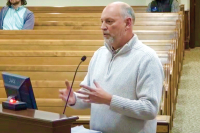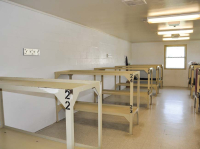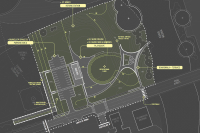Cherokee masks come in many guises
A mask is a mechanism employed to cover the face as a protective screen or disguise. For protection, they have been utilized for centuries by medieval horsemen, welders, fencers, hockey goalies, and so on. Their most intriguing uses, however, have been as a devices of disguise, as in a theatrical production or as part of the paraphernalia of religious and/or cultural ritual.
We don’t have to go to darkest Africa or the remote jungles of South America to find recent and extensive use of a variety of masks in this latter context. Until very recently they were an important element of Cherokee ritual.
A visit to the Qualla Arts and Crafts Mutual Inc. or other outlets in Cherokee will turn up a variety of the contemporary masks being produced by the reservation's carvers. They sometimes use skins or gourds, but for the most part masks are carved from buckeye or other suitable wood and then colored with natural dyes, paint, clay, charcoal, or shoe polish.
Often these modern masks simply depict a man with horns (the buffalo mask) or maybe a bear’s face. I am especially attracted to those haunting masks that are presented unadorned as a skull-like rendering. A favorite theme of some carvers is that of a man’s head topped by a coiled rattlesnake. And then there are those grotesque or sometimes even obscene productions known as “booger masks.”
If you take the time to look up and talk with a Cherokee mask-maker, you’ll get a friendly enough reception (especially if you’re actually shopping for a mask), but you’re not likely to get much insight into their themes. These people just don’t make their living talking. They’ll say something like, “Oh, that’s just a snake that happens to be on that man’s head”; or, “Funny thing, I started in to carving and it just turned out that way”; or, “You think it looks like a what?”
Unless you happen upon an unusually talkative mask-maker in an unguarded moment, your best sources for detailed information on the Cherokee mask tradition are the book-length study Cherokee Dance and Drama (1951) by Frank G. Speck and Leonard Broom, and the article by Raymond D. Fogelson and Amelia B. Walker titled “Self and Other in Cherokee Booger Masks” that appeared in the fall 1980 issue of the Journal of Cherokee Studies.
Related Items
Cherokee Dance and Drama was written in collaboration with Cherokee mask-maker and cultural authority Will West Long. Others who contributed to the book were Long’s elder sister, Roxy, his elder half-brother Lawyer Calhoun, Deliski Climbing Bear, and Mrs. Sampson Owl. This book is the real thing.
Will West Long — the son of Sally Terrapin and John Long, a Baptist minister — was born about 1870 in the traditional Big Cove section of the Qualla Boundary. After attending a school near High Point, he returned to Cherokee at the time the famous ethnologist James Mooney was there collecting data for his book subsequently published in 1900 as Myths of the Cherokee. Mooney hired Long as a scribe and interpreter.
Long later attended Hampton Institute and lived in New England until he was in his mid-30s. He returned once more to Cherokee shortly before his mother died in 1904, married, and spent the remainder of his life on the reservation.
His mother's interest in such matters, along with Mooney’s influence, created in Long a passion for preserving the quickly fading history and social customs of the Cherokee. He acquired manuscripts and insights from the medicine men that would otherwise have been lost. Long is rightly considered by many to be the authoritative scholar of his people’s customs during his lifetime.
In addition to his other interests, Long helped preserve the traditional dances and became one of the community’s foremost mask-makers, a craft he learned from a cousin, Charley Lossiah. Allen Long succeeded his father as the tribe’s top mask-maker during the early 20th century.
As described in the sources cited above, the Booger Dance (also called the Mask Dance) was a ritual performed after the first frost that featured masks which exaggerated human features; that is, they represented racial types: Indian man (a dark red face); Indian woman (light red face with paint on cheeks) white man (woodchuck or opossum fur as a beard); black man (charcoal colored); and so on.
What made the booger masks exceptional were the sometimes grotesque, often humorous, and usually obscene elements incorporated into them that suggested European features like bushy eyebrows, mustaches, chin whiskers, big noses, ghastly white pallor, and bald heads.
The boogers — generally depicted as older men — represented “people far away or across the water” (Europeans, blacks, northerners, southerners, alien Indians) who intrude upon the peaceful social dances of the Cherokee. Upon entering the dance house, they break wind, chase women, and generally behave as barbarians. Asked what they want, the boogers first reply “Girls!” then announce that they want “To fight!” Instead of reciprocating, the Cherokee allow them to dance out their hostilities.
This ritual has been interpreted in several ways. It was a way to deal with “the harmful powers of alien tribes and races, who, as living beings or ghosts, may be responsible for sickness or misfortune.” It also served as “condensation of the acculturation process as seen from the Cherokee perspective: first the white man tried to steal women; second he wanted to fight; and then, finally, he was satisfied to make a fool of himself.”
It’s also clear that many of the ingeniously crafted masks used in the ceremony simply poked fun at boorish masculine traits in general, including the “excessive preoccupation with sexuality” and the desire to be “in charge.”
And so, my friend, always remember that masks are mirrors ... the next time you spot a Cherokee booger mask in a shop, at one of the craft festivals, or in a museum, pause and take a closer look ... it just might be looking back at you.
George Ellison wrote the biographical introductions for the reissues of two Appalachian classics: Horace Kephart’s Our Southern Highlanders and James Mooney’s History, Myths, and Sacred Formulas of the Cherokees. In June 2005, a selection of his Back Then columns was published by The History Press in Charleston as Mountain Passages: Natural and Cultural History of Western North Carolina and the Great Smoky Mountains. Readers can contact him at P.O. Box 1262, Bryson City, N.C., 28713, or at This email address is being protected from spambots. You need JavaScript enabled to view it..









